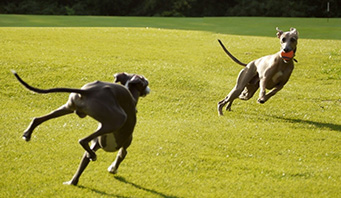All about being owned by an Italian Greyhound!
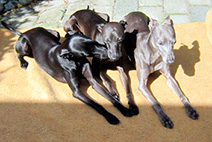
"Gorgeous, elegant, refined, naughty, cheeky, loving, attention-seeking, confident, nervous, bold, shy, curious, aloof, friendly, greedy, skinny, fast, lively, fragile" - all good words to describe Italian Greyhounds – small dogs packed full with personality.
Many dog breeds are keen to please their owners and come to them as if to ask: "What can I do to please you?" Italian Greyhounds come to their owners and clearly tell them: "Now, what can YOU do for me?"
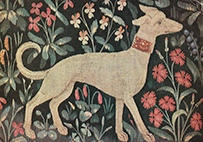
An ancient breed, Italian Greyhounds have been depicted in art and sculpture for thousands of years, and can be traced back to Ancient Egyptian times. They are depicted in Egyptian hieroglyphic pictures and often featured alongside larger hounds, which were probably forerunners of the full-sized Greyhound. The large and small hound types migrated over time, and there is much evidence in paintings and sculptures, of a miniature hound in the times of the Roman Empire. Many of the sculptures found in the Room of Animals, in the Vatican are of small hounds, identified as Piccolo Levriero Italiano (Italian Greyhound). In particular, there are two sculptures both depicting two Italian Greyhounds, one chewing the ear of the other. They are very similar, though not identical.
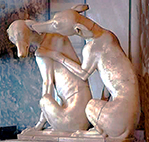
One is to be found in the Vatican, the other in the British Museum in London. Their name comes from a surge in the popularity of the Piccolo Levriero Italiano during the Renaissance period in Italy, where it was depicted in many paintings, as they became favourite companion dogs for the Italian nobility. Whilst the men were hunting and warring, the ladies remained at home, tending their little charges.
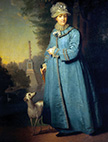
The breed made its way to the United Kingdom in the first half of the nineteenth century, where they became known as Italian Greyhounds. The first volume of The Kennel Club "Calendar and Stud Book", published in 1874, lists forty of them.
Italian Greyhounds are from the same genetic Sighthound family as Whippets, and Greyhounds, to name a few.
In the UK and USA Italian Greyhounds are classified as "Toy Dogs" by the official Kennel Clubs but in Europe they are classified as Sighthounds. The official Italian Greyhound Breed Standard outlining the desirable physical characteristics of Italian Greyhounds is available on this site, see link at the top.
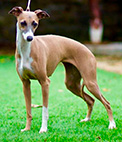
Temperament
It’s hard to make generalisations about the personalities of Italian Greyhounds as ‘nature’ and ‘nurture’ play a huge part in determining whether or not an Italian Greyhound develops to become a well-balanced, well-socialised, happy and healthy dog but be warned – they are not quiet little house dogs and demand a lot of your time, energy and attention!
Reality check – Italian Greyhounds are NOT small Whippets or Greyhounds and they’re generally full of energy all day long – and well into old age!
Italian Greyhounds are bright, intelligent and curious little dogs who will find things to do if you don’t provide adequate entertainment. Sounds cute? It can be and you’ll have many a laugh. But at other times it can be very annoying. Any Italian Greyhound owner will tell you that if you spend too much time on the phone or on your computer, they will come and tell you what they think of that, either by pestering you or going off and getting into trouble...
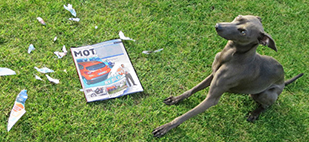
...shredding a magazine or a loo roll is a popular attention seeking stunt.
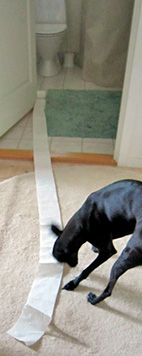
Therefore, regular exercise is very important for Italian Greyhounds - though you can expect them to fly around your home even after they’ve been out for a long walk.
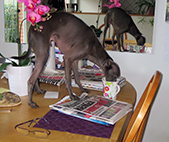
Meeting the real thing!
If you want to meet some Italian Greyhounds in person and chat with knowledgeable owners then you are very welcome to come and join us at one of our Club Shows, Club "Fun Day" or a meet up walk with a breeder or owner. Meeting IG owners and the IGs themselves is the best way to get to know them! See link above to Contacts you can speak with and also Show news. And if you’re thinking about giving a home to an Italian Greyhound please take time to read on for all our advice.
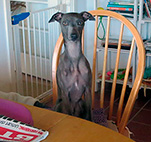
Home alone
Italian Greyhounds have been bred as companion dogs for many centuries and as such they crave attention, interaction and love from their human owners. As a breed they are not suited to homes where the owners do not have time to interact with them regularly throughout the day, nor will they thrive if left alone at home on their own for long periods of time every day.
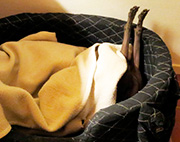
In fact, an Italian Greyhound that doesn’t get enough interaction and mental stimulation can quite easily end up being a "problem dog" – with the problem merely being caused by its unsuitable routine and environment as opposed to an inherent psychological problem. It helps if at least one member of the household does not have to leave the home all day.
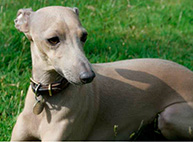
That said there are of course many Italian Greyhound owners who have happy, healthy dogs who do work away from home all day. Important to note though is that almost all of these people make additional care arrangements for their dogs e.g. a friend / neighbour / dog walker / dog sitter visits and/or walks/feeds the dog during the day to ensure that the Italian Greyhound is not left on its own for too long a period of time.
Opinions vary on what is ‘too long’ for an Italian Greyhound to be on its own. For the sake of putting a marker in the sand 4 hours is about the maximum length of time that most people would be prepared to leave their Italian Greyhounds on their own. They cannot be expected to ‘hold themselves’ for many hours either, so avoid "accidents" on the floor by never leaving them alone for more than they can bear.
(Tips about
to train your dog to be clean in the house here: www.sighthound.net/cleanpups.htm)
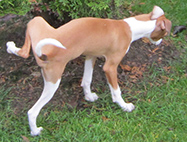
Having extra help is definitely worth considering if you are thinking about an Italian Greyhound as a companion dog, especially if you have a busy work life or busy social life. Do you have someone you trust who you would allow to enter your home and take care of your dog unsupervised? Do you have the financial leeway to be able to hire a dog walker or dog sitter? Or would it be easier for you to have a breed of dog that doesn’t require the one-on-one love and masses of attention that an Italian Greyhound does?
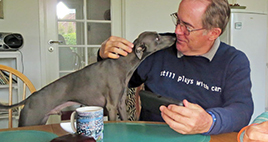
With any household it is of course impractical to think that the family dog should never be left at home on its own. In fact, a healthy, well-balanced dog should be able to be on its own for short periods of time without suffering from any stress or anxiety. When you do leave your Italian Greyhound at home for short periods of time, make sure it’s in a safe environment. As a puppy this can mean confined to a suitably sized play-pen or crate.
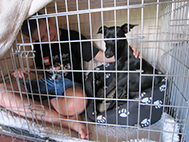
(N.B. for short periods of time only – see our section on Crating and crate training.)
Tip: Make a habit and little ritual of letting your Italian outside to potty just before you leave him/her alone. Tell the dog what you want it to do, it will quickly understand.
As your Italian Greyhound grows older and wiser it is best to restrict it to certain appropriate and warm rooms while you are out. Never leave a young puppy to roam free around your home when you are not there to supervise.
Accidents can and will happen.
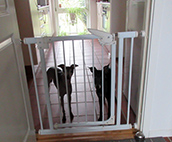
It is also well worth investing in "baby gates'" over certain doors to prevent puppies accessing stairs unsupervised or areas which might be unsafe i.e a hall when an open front door could tempt it to run outside!
Exercise
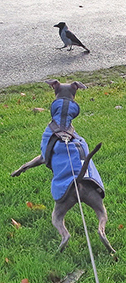
Italian Greyhounds need good exercise.
Most of the books on Italian Greyhounds state that the breed needs light exercise. We totally disagree! They are high energy dogs and unlike their larger Greyhound cousins, they also have stamina and need to burn off some of their endless reserves of energy! Even at a quick glance, one can see that they are built for being energetic athletes who love running and jumping fast. Italian Greyhounds need to be allowed to free-run only where it’s safe to do so – their high energy levels means they can keep going for hours!
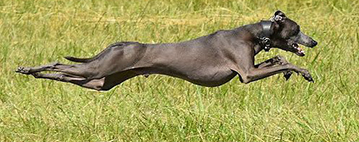
Obviously, you need to have trained your dog to come back to you for a treat reward when called, before doing this. Ideally Italian Greyhounds should have minimum one walk every day for at least an hour. Important: Exercise for puppies who are still developing their bodies is of course different.
Walks for puppies and juniors should be shorter and gentle at first to slowly build up the muscles without putting undue stress on young, growing bones or getting over-tired.
Despite being classified as Toy Dogs in the UK, Italian Greyhounds are very much Sighthounds and their hunting instinct can be very highly tuned. Therefore, always bear in mind that if they see anything that looks even vaguely like it’s worth chasing, they will do so and there are very few Italian Greyhound owners who can honestly claim that their pooch would stop mid-chase on being called! Many an Italian Greyhound owner has let their dog off the lead only to see it shoot off after a rabbit and then spent the next 30 minutes wondering if the little dear was ever going to come back!
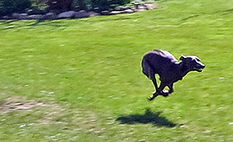
All dogs need to be walked in the great outdoors – and this gives extra healthy owners too! Exercise is not just about physical exercise it’s also about mental stimulation for the brain. Imagine being stuck within the same four walls every day, day after day – most of us would go stir crazy and dogs are no different. Sniffing new smells, seeing different things, hearing different sounds – this is all critical to ensuring that your dog is well-balanced and well-socialised. (Treadmills are a novel and modern idea for exercising dogs but then you may as well have a hamster in a wheel.) When exercising your dog, make sure you do so responsibly. You should have full control over your dog, and it should not be allowed to pester other people, dogs or other animals such as livestock in country fields. Neither should you be near main roads where it coudl risk being run over.
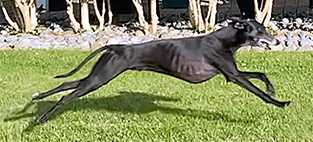
Tip: Training your dog to come to a "soundless" dog whistle is good as this carries much further than a slightly hysterical owner calling - plus it has the advantage that anyone else can use the whistle meaning everyone walking the dog all sound the same when calling it back. Note: Always carry poop bags to clean up after your dog.
Warning: Larger and very lively dogs can see your Italian Greyhound as ‘prey’ and give chase, you must be mindful of this.
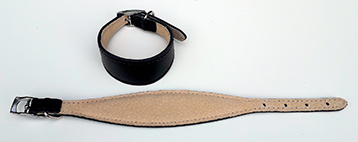
Walking paraphernalia
It is a legal requirement in this country that all dogs must wear a collar with an identification device as a minimum bearing the owner’s name and address including house name or number, when in a public place. Include your telephone or mobile number as well, so anyone finding your dog can instantly get in contact with you.
You need a suitable, well-fitting collar and a lead, perhaps also a harness.
Italian Greyhounds have long, sensitive necks and it’s a good idea to use a traditional Sighthound collar which is wider at the front than at the back so that the pressure from the collar is spread more evenly on the throat.
Sighthound collars are also more secure than slim straight collars – because Italian Greyhound heads are relatively small and therefore they can slip out of the thin collars more easily.
A good alternative to a collar is a harness and there are several specialist makers of harnesses for Italian Greyhounds in the UK and online. The Italian Greyhound body shape and proportions, as well as a very fine coat and thin, sensitive skin, means that it’s very important that the harness fits the Italian Greyhound correctly. The standard nylon harnesses that you find in most pet stores are not suitable for the special deep-chested body the Italian Greyhound has. They more often than not will rub and chafe the dog, sometimes causing painful ‘burns’, cuts and blisters.
Important: Some people use extendable leads but many Italian Greyhound owners steer clear of them because of the injuries that can be sustained as the breed can accelerate extremely quickly and dash forward at great speed - and when they reach the end of the lead, the backlash on the delicate neck can be severe. Therefore, always use a harness with an extendable lead.
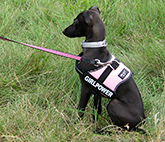
Grooming
Perhaps the only time you’ll ever hear ‘low maintenance’ and ‘Italian Greyhound’ in the same sentence! The reason being that as a very short-coated breed, Italian Greyhounds do not require a lot of grooming.
Essential Grooming tasks
1. Check your dog every day to make sure it’s in good health – run your hands over every part of his/her body and make sure you take a look in his/her ears and "arm-pits" in case there’s anything nasty lurking in there like a tick, and check their paw pads too for things like grass seeds.
2. As Italian Greyhounds are a short-coated breed they tend to ‘wipe down’ easily after a muddy walk, either with just a wet, soft towel, or with the dog wipes that are readily available in pet stores, so you rarely need to bathe them.
3. Teeth must be brushed daily – a soft-bristle children’s toothbrush with a canine toothpaste that tastes good. Many love "poultry taste"!
Gum disease and dental problems are prevalent in Italian Greyhounds and daily brushing goes a long way to helping prevent these problems in the long term. This can save huge amounts of money otherwise spent at the vets who clean the teeth under general anesthetic.
Tip: Squeeze a little toothpaste onto the base of your forefinger and then you can easily ‘dip’ into this as you work your way around the rows of teeth.
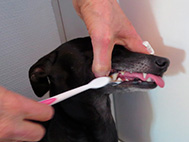
4. Nails must be trimmed regularly – usually every 1-2 weeks depending on the dog.
5. If you find that your Italian Greyhound really does need a ‘proper’ wash bear in mind that they don’t generally like water, and definitely not being submerged in it. If you are going to wash them then a warm, (test the temperature first), wash with a hand shower (not a high-pressure spray), is a relatively easy way of doing it and be careful of using any shampoos – Italian Greyhounds have very delicate skins and most shampoos, including dog shampoos, can be too harsh. Be sure to rinse well. Baby Shampoo is used by some owners.
In a nutshell,
Italian Greyhounds are not the most cooperative of breeds when it comes to doing what you want them to do. However, it is possible to obedience train an Italian Greyhound, but it requires a degree more wit and cunning on the part of the human plus rewarding with some good, small treats, than with many other dog breeds. Puppy training classes and even adult training classes are a good idea, especially if you are a first time dog owner.
Training classes are about training humans to train their dogs. Training is not just about making your dog do what you want though – it’s also a great opportunity to build trust in the relationship between you and your dog, and classes provide a good socialisation opportunity for your puppy/dog.
Please read our "Check list" for what you need as a coming new IG owner!
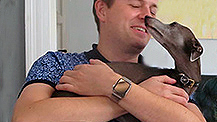
Note: Please only take part in training classes that use humane training methods eg. with positive reinforcement methods such as clicker training. If you are at all unhappy with the training methods prescribed, then trust your gut instinct and find another training class. This is because Italian Greyhounds can be very sensitive and they are very intelligent and easily get bored, so you need to bear this in mind. Remember: Obedience training should be fun and rewarding, not stressful or frightening. Read all about crate training, click here.
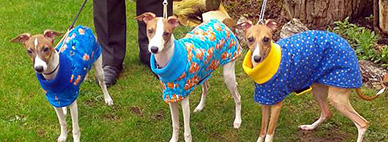
Clothing for all weather
This is not a joke, nor some kind of doggie fashion statement!
It is essential that you are able to keep your Italian Greyhound warm on walks in cold and wet or windy weather!
Italian Greyhounds have the finest of fur coats and extremely thin skin over their muscles, so they feel the cold far more than many other breeds. Most homes have central heating nowadays so indoors is generally not a problem.
So what does your Italian Greyhound need in its wardrobe?
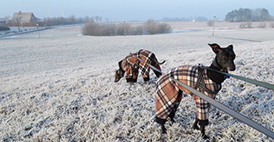
We recommend at least one jumper or body warmer and one waterproof raincoat, but you’ll soon find that you need quite a wardrobe for your dog so you have something appropriate for whatever the weather!
The unusual size and body shape of an Italian Greyhound makes it difficult, if not impossible to find jumpers and coats to fit the breed in standard pet stores. A jumper which is completely the wrong shape won’t do much to keep your dog warm and could be very uncomfortable.
However, there are a large number of companies and individuals who make Italian Greyhound clothing – just search on the Internet for ‘Italian Greyhound Coats’ or "The Italian Greyhound collection".
The Italian Greyhound Club have their own breed stall at shows selling coats, collars and beds.
If you are having difficulty finding what you need for your dog then just contact us as we can always post items to members. Italian Greyhounds demand their creature comforts – most will look at you with a forlorn expression if you even suggest going outside in the rain. However, with a warm jumper and a good raincoat there is no reason at all why they, (and you), should not walk out whatever the weather! After 5 minutes of telling you it’s all wrong to be outside on a rainy day, they give up and thoroughly enjoy the whole walk – if dressed in the right apparel!
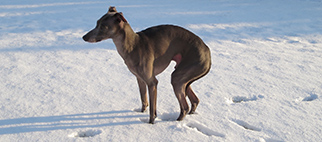
In extreme weather conditions, e.g. below freezing temperatures and deep snow, use your common sense.
Your Italian Greyhound will still need exercise but not at the expense of freezing its paws off.
Also, be aware that the salt used on icy pavements can be painful under their feet.
Feeding Italian Greyhounds
In general, the breed doesn’t have any particular dietary needs beyond a good quality, balanced ‘complete’ dog food suitable for an active breed. Unless you have particular knowledge of dog nutrition it is best to stick to feeding complete foods rather than trying to “mix it up” yourself as it’s unlikely you will cover all of your dog’s nutritional needs.
A good starting point is to continue for a while with the same food your breeder uses/recommends.
Then if you do decide to change the brand, introduce the new feed gradually over a couple of days.
Tip: We recommend feeding 3 meals a day:
A very small breakfast – they are extra hungry as many hours have passed since the last meal the previous day.
Then a very small lunch and lastly a fair-sized dinner so they can feel nicely “full up” for the first time and settle down to relax for the evening.
But remember that all dried food naturally swells up in water or in the stomach so when giving a portion, bear in mind how much your chosen brand can swell. Some can swell from twice to up to four times the size after a few hours in the stomach, all depending on the brand. (Test by putting a piece in a glass of water for two hours.) Italian Greyhounds have small stomachs tucked up under the rib cage and should never eat too much at any one time.
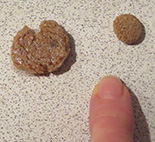
There is a huge variety of dog food on offer when it comes to dog food – from dry feeds (kibble) to wet feeds, (traditional tinned dog food), to raw feeds and freeze-dried feeds. Fish-based feeds, meat-based feeds - the list goes on.
As a general rule, avoid feeds that contain a high percentage of ‘fillers’ such as wheat, rice, grain and other cereals.
Fillers do just that – fill your dog’s tummy but provide very little nutritional value.
Here’s a brief overview of each type of feed:
Dry feed (kibble):
concentrated dog food which has been made into small pellets. Very convenient as it can be stored in an airtight bag and is available to feed immediately. People who choose not to feed their dogs on kibble will often have a small bag in their cupboard as a back-up. As with all foods, different brands and types of kibble deliver different nutritional quality.
Always add a little water so the dog doesn’t choke on the dry particles.
Wet feed:
traditionally found in tins in the supermarket.
Convenient in that you can store this in a cupboard and it’s available immediately.
Wet food has seen some significant developments in nutritional quality with many different brands. You must experiment to find out what suits your Italian best.
Raw feeds:
Raw diets are increasing in popularity in this country.
The principle is as it sounds – feed made of raw food, i.e. raw meat with some vegetable content, just as wild dogs would eat naturally. There are now several companies in the UK offering good quality raw ‘complete’ foods that contain raw meat, ground bone, vegetables, fruit and other vitamin and mineral content.
Raw food is delivered frozen and needs to be stored in a freezer and you have to remember to thoroughly defrost a portion to room temperature before giving it to the dog - so it’s lower on the ‘convenience scale’ than dry and wet feeds.
Freeze-dried Raw Feeds:
an innovation in the raw feed market is freeze-sdried raw food – the same nutritional benefits of the raw diet but with freeze dried food it does not need to be kept in a freezer and thawed out seveal hours beforehand.
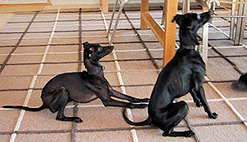
Treats for your Italian Greyhound
Most Italian Greyhounds are greedy guzzlers despite their air of refinement and elegance! Like most dogs they enjoy treats, but treats should be given occasionally as opposed to becoming part of the regular feeding routine throughout the day.
There are times when you may need to give your dog lots of treats, e.g. When you are training them, but just bear in mind that if a dog is having a lot of treats, their main feed should be reduced accordingly.
Tip: Just a tiny morsel of its normal kibble, (or another "taste"), is enough as a reward.
Maintaining a healthy weight It is important that you help your Italian Greyhound to maintain an appropriate weight for its size. Too skinny is not healthy and neither is obese.
As a general rule you should just be able to see the hip bones on the rear of your Italian Greyhound, and the ribs should be lightly covered, so you can see just a hint of them especially when the dog breathes in deeply. So take a critical look at your dog before each feed. Is he/she getting fatter or thinner - or "just right"?
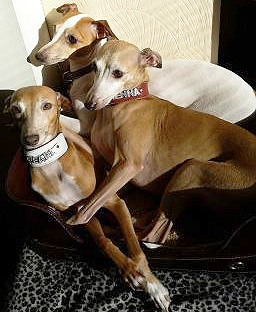
Italian Greyhounds are elite athletes and not built to carry large amounts of fat so you should not let your Italian Greyhound become overly pudgy – not only because of how it looks but because of the potential health implications, not least all that extra pressure on its fine bones and joints and a strain on the heart.
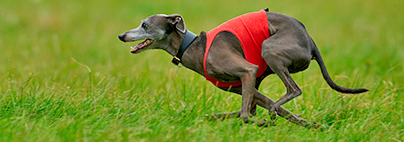
Put frankly, if you want a chubby dog then choose a stockier breed!
(Very often, lack of good running exercise lies behind overweight dogs.)
If your Italian Greyhound is too skinny and won’t eat enough food to put on weight despite trying different food, then contact your vet for advice as it is always worth checking whether or not there are any health issues lurking.
Health
Always register your dog with your nearest vet as soon as you bring your Italian Greyhound home. Vets can be a fantastic source of advice and support, particularly if you are a first-time owner.
Vaccinations
Always ask the breeder what vacinations and the date that your puppy has had already. Speak to your vet about vaccinations and boosters that your dog will need throughout its lifetime and ensure that they are kept up to date.

Flea Treatment
Please be aware that many vets offer flea treatment BUT this is NOT recommended as this CAN be very dangerous for IG’s. Please see article on Flea treament under IG Health, (link above or below), for more information.
Worming
They also need to be regularly wormed, ask advice from your breeder or your vet.
Microchips
It is a legal requirement to have your dog micro-chipped. Remember to transfer the microchip details into your name when you get your puppy, and keep them updated at all times. You can be fined for out-of-date microchip details.
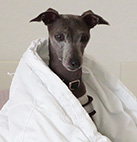
In relative terms Italian Greyhounds are a healthy breed but there are also some key health issues that owners need to be aware of. Broken legs are one and Periodontal Disease and Epilepsy are two of the others that are causes of concern. Always remember, The Italian Greyhound Club will happily put you in touch with experienced Italian Greyhound owners if you want any advice on the breed in general.
Visit our Breed Health site, link above/below.
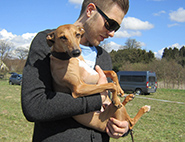
Leg Breaks
Italian Greyhounds have long, fine leg bones that are a bit like pencils – and we all know how easy it is to snap a pencil. However, it is not the norm for every Italian Greyhound to break a leg! Accidents can happen to any dog – as with humans.
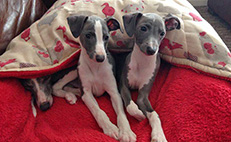
Use your common sense and you will go a long way to preventing nasty accidents e.g. don’t let puppies leap off furniture onto hard, polished floors, don’t let your Italian Greyhounds run in rutted or pot-holed fields but instead let them run in safe areas so they build bone and muscle strength.
Those who are new to the breed and searching for a companion dog should ask any potential breeders about whether or not the sire and dam have had problems with leg breaks.
And use your eyes – an overly-fine dog that looks fragile probably IS fragile.
Insurance
Always insure your dog – especially puppies. It can cost thousands of pounds to have a broken leg re-set properly by a specialist orthopedic vet. Having financial help to paying a huge vet. bill can save a dog's life.
NB: Please read our "Check list" for what you need as a coming new IG owner!
